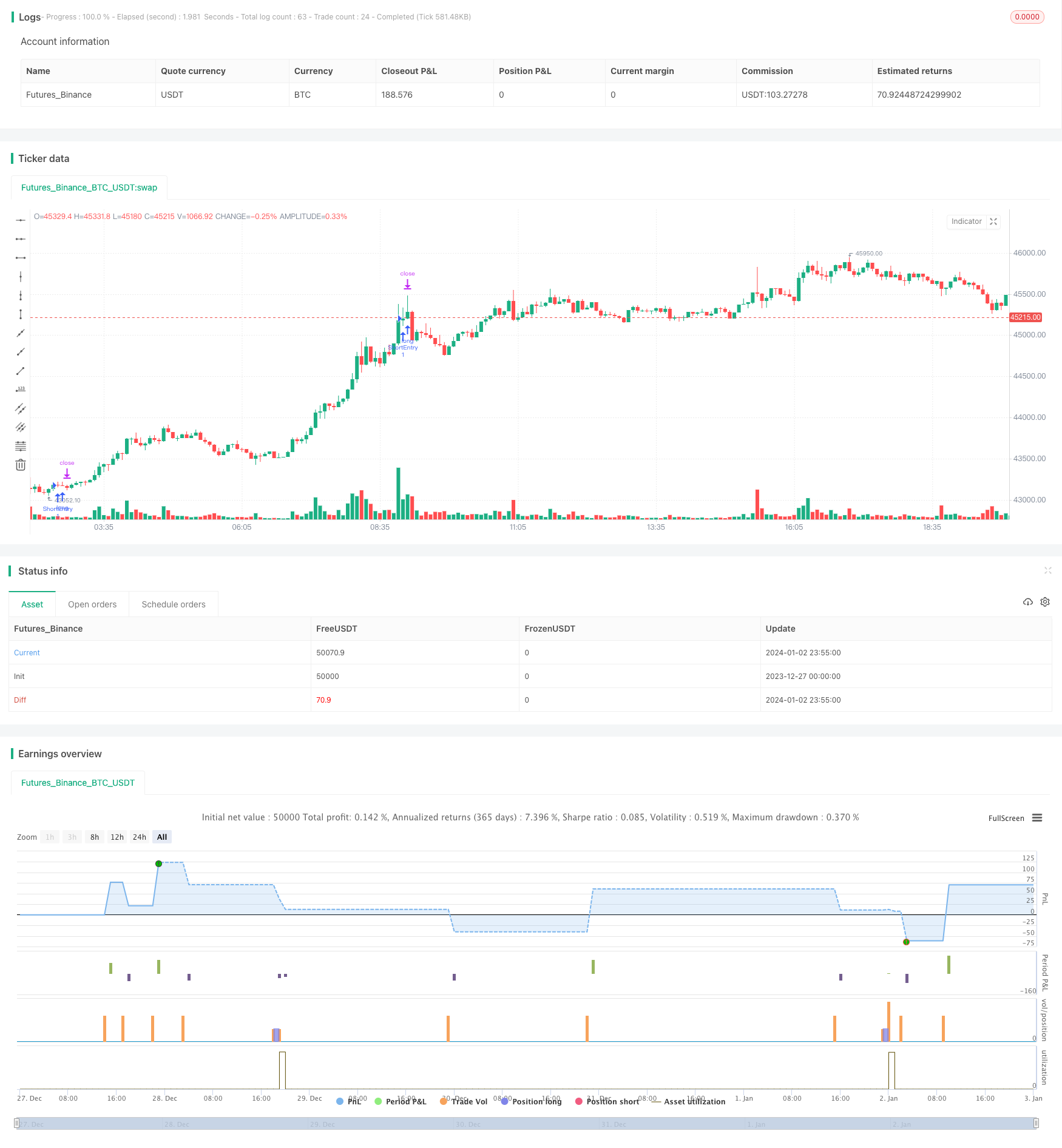
概述
本策略是一个利用ADX指标来过滤突破信号的短线交易策略。当价格突破 Bollinger 布林带上轨,且 ADX 在下降时,做空;当价格突破 Bollinger 布林带下轨,且 ADX 在上升时,做多。该策略同时设置止损和止盈,全自动交易。
策略原理
本策略使用 Bollinger 布林带作为主要的突破信号。布林带上下轨代表了价格的两倍标准差,价格突破布林带通常代表价格进入强趋势阶段。另外,为了避免虚假突破,本策略新增了 ADX 指标作为过滤条件。只有当 ADX 下降时才考虑布林带上轨突破;只有当 ADX 上升时才考虑布林带下轨突破。这样可以过滤掉部分震荡行情中的假突破。
具体来说,本策略使用长度为 33 周期的收盘价计算布林带。布林带中轨线为收盘价的 33 周期简单移动平均线,上下轨分别是中轨上下两个标准差。指标参数设置为当收盘价跌破上轨,且 8 周期 ADX 小于 15 周期 ADX 时做空;当收盘价突破下轨,且 8 周期 ADX 大于 15 周期 ADX 时做多。平仓设置为止盈 800 个点,止损 400 个点。
优势分析
这是一个结合趋势和次数指标过滤信号的突破策略,有以下几个优势:
- 使用布林带判断趋势突破点,比较符合大部分交易者的习惯。
- 增加 ADX 条件过滤,可以减少趋势震荡期间的虚假突破带来的损失。
- 策略操作简单,容易理解和优化。
- 自动设置止损止盈,无需人工干预,适合算法交易。
风险分析
本策略也存在一些风险:
- 布林带参数设置不当可能导致信号过于频繁,交易成本增加。
- ADX 设置不当也可能过滤掉部分有效信号。
- 止损距离可能过大,单笔损失扩大。
为了降低这些风险,我们可以调整布林带参数,缩小布林带范围;调整 ADX 周期参数,避免过度过滤信号;适当缩小止损距离,控制单笔损失。当然,这些优化都需要经过回测验证,避免过拟合。
优化方向
本策略还有进一步优化的空间:
- 可以测试不同市场的数据,寻找最优参数组合。
- 可以结合其他指标进一步过滤信号,例如交易量,Moving Average 等。
- 可以采用机器学习的方法自动优化参数。
- 可以考虑动态止损和止盈。
总结
本策略整体来说是一个简单实用的突破过滤策略。通过布林带判断趋势,ADX 过滤信号,可以在一定程度上规避震荡市的噪音,抓住趋势机会。优化空间还很大,值得进一步测试和改进。
策略源码
/*backtest
start: 2023-12-27 00:00:00
end: 2024-01-03 00:00:00
period: 5m
basePeriod: 1m
exchanges: [{"eid":"Futures_Binance","currency":"BTC_USDT"}]
*/
//@version=4
strategy("Hizbullah XAUUSD Sniper", overlay=true)
Price = close
Length = input(33)
Mult = input(2)
Basis = sma(Price, Length)
StdDev = Mult * stdev(Price, Length)
Upper = Basis + StdDev
Lower = Basis - StdDev
ADX_Length = input(4)
TrueRange = max(max(high-low, abs(high-nz(close[1]))), abs(low-nz(close[1])))
SmoothedTrueRange = sma(TrueRange, ADX_Length)
DirectionalMovementPlus = high-nz(high[1]) > nz(low[1])-low ? max(high-nz(high[1]), 0): 0
DirectionalMovementMinus = nz(low[1])-low > high-nz(high[1]) ? max(nz(low[1])-low, 0): 0
SmoothedDirectionalMovementPlus = sma(DirectionalMovementPlus, ADX_Length)
SmoothedDirectionalMovementMinus = sma(DirectionalMovementMinus, ADX_Length)
DIPlus = SmoothedDirectionalMovementPlus / SmoothedTrueRange * 100
DIMinus = SmoothedDirectionalMovementMinus / SmoothedTrueRange * 100
DX = abs(DIPlus - DIMinus) / (DIPlus + DIMinus)*100
SmoothedADX1 = ema(DX, input(8))
SmoothedADX2 = ema(DX, input(15))
Condition1 = crossunder(Price, Upper) and SmoothedADX1 < SmoothedADX2
Take_Profit = input(800)
Stop_Loss = input(400)
strategy.entry("ShortEntry", true, when = Condition1)
strategy.exit("ShortExit", "ShortEntry", profit = Take_Profit, loss = Stop_Loss)